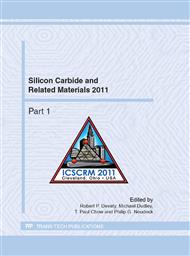[6]
The effects of electrical stressing and annealing on the reverse leakage follow the same behavior. It degrades with electrical stress as previously reported [3]. This work also shows that annealing returns the diode to nearly its original leakage curve, which confirms that the SSF introduces a leakage path through the drift layer. As a control, the diode free of BPDs and HLAs was also subjected to the same electrical stress and annealing. Its forward voltage I-V and reverse leakage I-V curves remained unchanged during the stressing and annealing sequence. Fig. 3. UVPL images and schematics of HLA expansion. The plan-view UVPL image (a) shows two HLAs before faulting and (b) – (d) show the expanding stacking faults. The cross-sectional schematics (e) – (f) illustrate how the expanding stacking faults eventually completely span the epitaxial layer. The details of the SSF that develop from a HLA explain the reversible behavior of the forward voltage and reverse leakage. The expanding SSF that originates from the BPD segments of the HLA is illustrated in Fig. 3. Frames (a) - (d) are UVPL images from a different wafer in which the SSF expansion was driven by extended UV exposure and recorded as it expanded. Both UV exposure and current injection in PiN diodes introduce excess electrons and holes, and the recombination of these excess carriers drives the SSF expansion [[] A. Galeckas, J. Linnros, and P. Pirouz, Appl. Phys. Lett. 81 (2002) 883. ]. Each dot is from a half loop and the bottom of the half loop is a BPD segment [5]. Frame (a) is at the initial expansion and the two HLAs still appears as two vertical rows of dots. Frame (e) is a cross-sectional schematic with the location of the BPD segments. This frame illustrates that initially they are very localized and unlikely to provide a leakage path through the epi. In frames (b) - (d), the SSFs expand and coalesce. Frames (f) - (h) show their expansion along basal planes as they extend towards the substrate and towards the top of the epi or anode layer in the case of the PiN diodes. This expansion continues until the SSFs fill the basal plane between the substrate and top of the epi. Contraction of the SSF after expansion is illustrated by the UVPL images in Fig. 4. Frames (a) - (d) show the early stage of expansion before the individual SSFs coalesce as shown in Fig.3. As described elsewhere, the conditions are changed to cause the contraction in frames (e) - (h) back to the original HLA [[] N. A. Mahadik, R. E. Stahlbush, J. D. Caldwell, and K. D. Hobart, these Proceedings. ]. This demonstrates that the SSFs originating from the BPD segments of the HLAs are the source of the reverse leakage displayed in Fig. 2. As shown in Fig. 1, HLAs commonly extend across the active device area under the anode and the fully expanded SSF forms a leakage plane spanning from the bottom to the top of the diode active area. The expanding SSFs are also responsible for the forward voltage increase. Conclusion Fig. 4. UVPL images of HLA expansion and contraction. In (a) – (c) stacking faults from the BPD segments in each half-loop are expanding. The same stacking faults are contracting back to the original BPD segments in (d) – (f). The expansion and contraction of Shockley stacking faults (SSFs) from half-loop arrays (HLAs) in 10 kV PiN diodes demonstrates that SSFs create a leakage path through the PiN drift region. Forward bias stressing expands SSFs across the PiN drift region, which significantly increases reverse leakage and forward voltage. Annealing collapses the SSFs and returns the reverse leakage and forward voltage to nearly their original behavior.
Google Scholar


